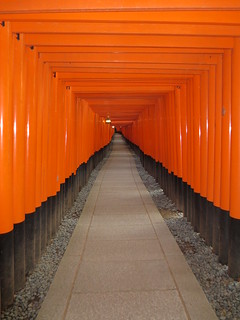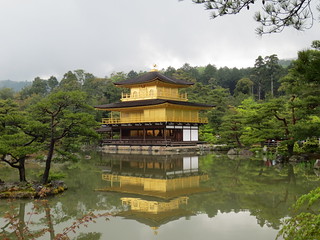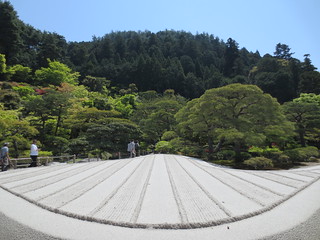We loved Kyoto and spent quite a lot of time immersed in history with several visits to temples and shrines so these are our experiences from Friday 26th April, Monday 29th April and Tuesday 30th April.
On the Friday we visited Fushimi-Inari Taisha; a shrine complex consisting of thousands of orange-red torii arranged along pathways around Mount Inari. Having seen it as a filming location in Memoirs of a Geisha we found it stunning in real life. We walked the 4km route up through the wooded slopes of the mountain which was wonderful in the late afternoon, early evening sunshine.
Kyoto is also home to one of the most sought after views in Japan – Kinkakuji, the Golden Pavilion. The original was built in 1397 as a retirement villa for Shogun Ashikaga Yoshimitsu and his son converted it into a temple. In 1950 a young monk had such an obsession with the temple that he actually burnt it to the ground. In 1955 a full reconstruction was completed that followed the original design with the addition of gold-foil covering to the lower floors.
We visited this on our final morning in Kyoto – sadly it was overcast but despite the rain it still made a magnificent sight. We can only imagine how stunning it would be in full sunshine.
A few days earlier we’d visited its ‘sister’ the Silver Pavilion. Whilst architecturally it’s not as arresting and isn’t actually covered in silver, the gardens are incredibly well-kept with raked cones of sand in the classic, Zen Garden style. I do not have the patience for this!
The silver pavilion is part of Kyoto’s Higashiyama region, a part of the city laden with gardens, temples and shrines. So, after leaving Ginkakuji we visited Honen-in, which is just a short walk down the hill – and away from the crowds! This temple was much smaller and the gardens weren’t as well kept, but with free entry there’s nothing to complain about. Autumn is really the best time of year to visit when the maple trees which line the approach to this temple turn a beautiful shade of red, but we thought it was none too shabby for springtime.
Further down the road is the ‘path of philosophy’. This path alongside a canal gets its name from Nishida Kitaro, a 20th century philosopher who used to stroll along the path whilst contemplating whatever it is that philosophers contemplate. We spent 30 minutes meandering along it and whilst we didn’t philosophise about anything particularly deep and meaningful we did enjoy the picturesque surroundings.
Bluntly, we were a little temple tired by this point – all of them are very similar and with no spiritual connection to these places we aren’t as engaged as a Buddhist might be (whilst maintaining the requisite respect for the devout). So when the path ended at Eikan-do we decided to give it a miss and instead opted for some delicious sushi.
We did still have a couple more sights we wanted to see and the first was Nanzen-in. As the home of one of the schools of Zen it would have been rude to pass up the opportunity to take a postcard picture for the GOV.UK helpdesk team (they use a tool called Zendesk to manage support requests). We wandered around the complex and took in Hojo, another Zen garden. This building complex and its Zen garden, with its raked gravel and its carefully placed rocks, trees and bushes is quite lovely but we felt it wasn’t a patch on Daikakuji.
Although we’d only just had lunch we spotted ice cream and had to stop – it was hot and temple touring takes its toll! We walked past the magnificent camphor trees outside Shoren-in (but didn’t go in) and kept on down the road to Chion-in, enticed by the Lonely Planet’s description of it as ‘grand’. Unfortunately, after walking through the giant San-mon and clambering up the massive steps we discovered the temple hall was encased in a gigantic shed because of renovation work until 2019. In keeping with the scale of all things humongous at this temple we hunted out the bell. Another giant piece of construction, and old too – it dates from 1633 and weighs 70 tonnes!
All of our pictures from Kyoto are arranged in this collection on Flickr.



